The church St Michel in Guard-Adhémar
 The borough of the Guard-Adhémar preserved its medieval structure,
enclosed in ramparts in edge of a rocky outcrop dominating the plain of
Pierrelatte.
The borough of the Guard-Adhémar preserved its medieval structure,
enclosed in ramparts in edge of a rocky outcrop dominating the plain of
Pierrelatte.
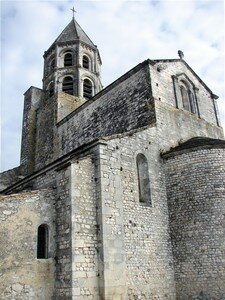 This
plain was colonized at the Roman time by the veterans of the Roman
legions (I th century). Recent archaeological research revealed many
traces of human occupation, partly related to a wine activity.
This
plain was colonized at the Roman time by the veterans of the Roman
legions (I th century). Recent archaeological research revealed many
traces of human occupation, partly related to a wine activity.
 Via
Agrippa to the foot Guard passed. Traces of Gallo-Roman habitat are
located in the hills. The site of the Valley of the Nymphs, to 2 km of
the current perched village, testifies to a worship to the divinities
of water and the goddesses mothers.
Via
Agrippa to the foot Guard passed. Traces of Gallo-Roman habitat are
located in the hills. The site of the Valley of the Nymphs, to 2 km of
the current perched village, testifies to a worship to the divinities
of water and the goddesses mothers.
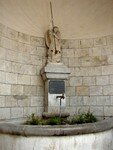 As
much of other churches of the Middle Ages built on heights, the church
of the Guard-Adhémar is dedicated to Saint Michel. The current Church
would have been set up at the time of second half of the XII th
century.
As
much of other churches of the Middle Ages built on heights, the church
of the Guard-Adhémar is dedicated to Saint Michel. The current Church
would have been set up at the time of second half of the XII th
century.
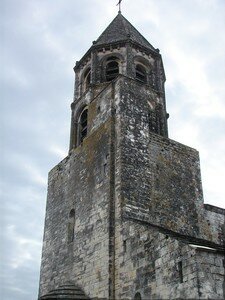 The
first mention of the presence in this place of a vault appears in a
bubble of the pope Pascal II of April 24, 1105. It is quoted among the
dependences of the Benedictine abbey Saint-Philibert of Tournus, of
which it concerned via the monastery the valley of the nymphs.
The
first mention of the presence in this place of a vault appears in a
bubble of the pope Pascal II of April 24, 1105. It is quoted among the
dependences of the Benedictine abbey Saint-Philibert of Tournus, of
which it concerned via the monastery the valley of the nymphs.
 It
became at the beginning of the XII th century parish church, dependent
on the abbey of Tournus until 1540, time when the pope Paul III gave it
to the chapter of the collegiate church of Grignan, which perceived the
incomes until the Revolution of them.
It
became at the beginning of the XII th century parish church, dependent
on the abbey of Tournus until 1540, time when the pope Paul III gave it
to the chapter of the collegiate church of Grignan, which perceived the
incomes until the Revolution of them.
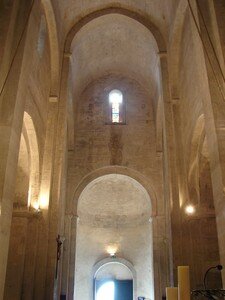 It was restored in 1849 and 1850 thanks to Mérimée, then inspector of the historic buildings.
It was restored in 1849 and 1850 thanks to Mérimée, then inspector of the historic buildings.
By
its style, this church belongs to the Romance school of Provence which,
by the play of the historical conditions, is related at the Rhénane
school, Provence belonging to the Saint Worsens Romain Germanique.
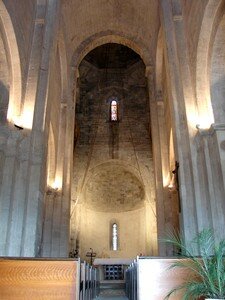 This
building of modest dimensions astonishes by verticality by its lines
not stopped by cornices. The two collateral ones, arched in quadrants,
are used as buttresses. One can notice his Western apse, particularly
rare architectural detail. Generally indeed, the apse is located in
direction of the East.
This
building of modest dimensions astonishes by verticality by its lines
not stopped by cornices. The two collateral ones, arched in quadrants,
are used as buttresses. One can notice his Western apse, particularly
rare architectural detail. Generally indeed, the apse is located in
direction of the East.
The Interior basilical with two spans does not have a transept.
 Slim
but small proportions: 3m 70 for the width of the spans. In all, 22
meters by 20 on the ground, the nave rising with 14 meters.
Slim
but small proportions: 3m 70 for the width of the spans. In all, 22
meters by 20 on the ground, the nave rising with 14 meters.
the stones of construction carry many concise signs, frequent marks of the maitres of work and companions. “Peturs” is most visible.
The bell-tower has two stages of arcades surmounted by a pyramid with 8 sides pointing out the "style clunisien" building, which had to the monks Benedictines. In 1849, there remained only the first stage and the base of the second.
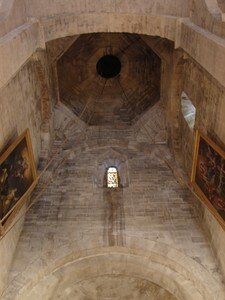 The
high part of the bell-tower, the second stage and the octagonal pyramid
which surmounts it are creations of the XIX th century, by the Questel
architect who took as a starting point an identical model with that
that the bell-tower of the major church of Borough-Saint-Andéol
represented. Also, when after the bombardments of 1944, one wanted to
restore the bell-tower of seriously damaged Borough-Saint-Andéol, the
architects had only to recopy that of the Guard-Adhémar.
The
high part of the bell-tower, the second stage and the octagonal pyramid
which surmounts it are creations of the XIX th century, by the Questel
architect who took as a starting point an identical model with that
that the bell-tower of the major church of Borough-Saint-Andéol
represented. Also, when after the bombardments of 1944, one wanted to
restore the bell-tower of seriously damaged Borough-Saint-Andéol, the
architects had only to recopy that of the Guard-Adhémar.
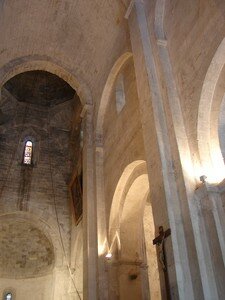 The
two apses are opposite, which is rare in France and finds itself
practically only in the old monuments of the edges of the Rhine. The
Eastern apse in hemicycle is framed by two absidioles, all the three
arched in half dome.
The
two apses are opposite, which is rare in France and finds itself
practically only in the old monuments of the edges of the Rhine. The
Eastern apse in hemicycle is framed by two absidioles, all the three
arched in half dome.
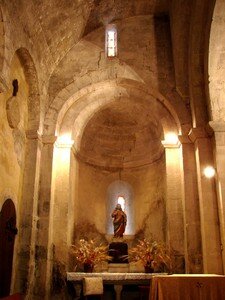 One
can notice the barrel vault broken on beams of the first two spans, the
cupola with 8 sides on conical horns of the last span.
One
can notice the barrel vault broken on beams of the first two spans, the
cupola with 8 sides on conical horns of the last span.
 On
the left of the entry, a truncated column that the old ones raised on
the tombs, called “cippe funerary”. One reads there the letters D and M
which must mean “Diis Manibus”, “with the gods manes”. It was
discovered in the valley of the nymphs.
On
the left of the entry, a truncated column that the old ones raised on
the tombs, called “cippe funerary”. One reads there the letters D and M
which must mean “Diis Manibus”, “with the gods manes”. It was
discovered in the valley of the nymphs.
 On
the right, a vestige of Gallo-Roman votive pagan furnace bridge carries
the inscription “Matris Nymphis”, which means “with the mothers nymphs”.
On
the right, a vestige of Gallo-Roman votive pagan furnace bridge carries
the inscription “Matris Nymphis”, which means “with the mothers nymphs”.
 An
altar stone to the sacrifices profiled on its 4 sides, was found in
the valley of the nymphs where it was used a long time as furnace
bridge for the catholic worship. It is used now as principal furnace
bridge.
An
altar stone to the sacrifices profiled on its 4 sides, was found in
the valley of the nymphs where it was used a long time as furnace
bridge for the catholic worship. It is used now as principal furnace
bridge.
 Outside, a plank seems me to represent the number of subsoil water currents as well as thetelluric ones and the faults.
Outside, a plank seems me to represent the number of subsoil water currents as well as thetelluric ones and the faults.
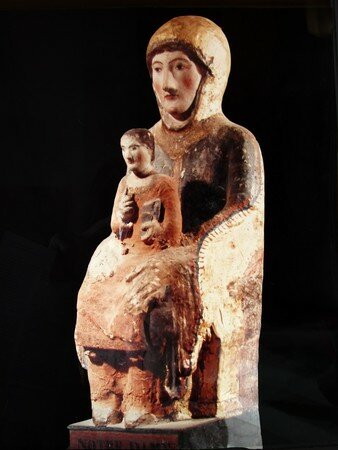 The
virgin with the child, of style auvergnat, out of wood, date probably
of the XI th century. It was discovered a few years ago by the abbot
Silhol, priest of the village, in his own church, whereas it was
dissimulated under embroidered clothes, crowns and the term of Holy
Anne.
The
virgin with the child, of style auvergnat, out of wood, date probably
of the XI th century. It was discovered a few years ago by the abbot
Silhol, priest of the village, in his own church, whereas it was
dissimulated under embroidered clothes, crowns and the term of Holy
Anne.
 The
statue spent long centuries venerated by the monks of the abbey of
Aiguebelle. But with the revolution, a monk walled the statue in a
niche, preventing which it does not undergo the sad fate reserved for
the virgin of Le Puy for example.
The
statue spent long centuries venerated by the monks of the abbey of
Aiguebelle. But with the revolution, a monk walled the statue in a
niche, preventing which it does not undergo the sad fate reserved for
the virgin of Le Puy for example.
 It
was to re-examine the day only with the XX th century. After its
rediscovery, the abbey of Aiguebelle made of it gift with the abbot
Girard, priest of the Guard-Adhémar, in 1944. The good priest could
only make some. He already had in his church a beautiful statue of the
virgin, polychrome, of the XVI th century, venerated by his
parishioners: Notre-Dame of the valley of the nymphs. It wondered one
moment if the new statue, Notre-Dame of the mercy, were not going to
carry wrong to that which was already in place since strong a long time.
It
was to re-examine the day only with the XX th century. After its
rediscovery, the abbey of Aiguebelle made of it gift with the abbot
Girard, priest of the Guard-Adhémar, in 1944. The good priest could
only make some. He already had in his church a beautiful statue of the
virgin, polychrome, of the XVI th century, venerated by his
parishioners: Notre-Dame of the valley of the nymphs. It wondered one
moment if the new statue, Notre-Dame of the mercy, were not going to
carry wrong to that which was already in place since strong a long time.
On the other hand, the church did not have a statue of Holy Anne, mother of Marie. Mister the priest eliminated the rival in an elegant and not very banal way. He equipped the statue with wood with ornaments of "saint-Sulpicien"style , Sainte Anne baptized it and issued that the Jesus child could honourably represent the Virgin Mary child. It placed under pane the statue and made register below: “Holy Anne request for us”.
 The
abbot Silhol, the current priest, is an enlightened art lover.
Intrigued by this strange Sainte Anne, it was to discover the truth and
to note with amazement which it was in the presence of a fort beautiful
testimony of the Romanesque art. (article of Olivier Tightens.)
The
abbot Silhol, the current priest, is an enlightened art lover.
Intrigued by this strange Sainte Anne, it was to discover the truth and
to note with amazement which it was in the presence of a fort beautiful
testimony of the Romanesque art. (article of Olivier Tightens.)
This statue has several of the characteristics of the black virgins. Within sight of the length of his hands, of his sitting position on the cathèdre, of the date of his “birth”, his proportions, I think that it good fleure the under-ground Lady… The place from where it comes is a magic place also, with or without its black virgin. I will make the article of it later. To announce: the virgin of the valley of the nymphs was stolen in 2006…
 Under
the church, with the feet of cliff, a garden of simple was arranged.
Surprised: a waste-gas main source nicely, taken care by a fauna.
During nymphs of the valley?
Under
the church, with the feet of cliff, a garden of simple was arranged.
Surprised: a waste-gas main source nicely, taken care by a fauna.
During nymphs of the valley?
 On the other side of the hill, other sources spout out, like that which attracted my glance while passing.
On the other side of the hill, other sources spout out, like that which attracted my glance while passing.
 It feeds the laundrette a little low, where some old stones are
embedded in the wall. The interior of the fountain impressed me much.
Still a place where water becomes crowned…
It feeds the laundrette a little low, where some old stones are
embedded in the wall. The interior of the fountain impressed me much.
Still a place where water becomes crowned…
 http://www.cs.cmu.edu/~celine/lga/la_garde-adhemar.html
http://www.cs.cmu.edu/~celine/lga/la_garde-adhemar.html
http://www.la-garde-adhemar.com/historique.htm
http://fr.wikipedia.org/wiki/La_Garde-Adh%C3%A9mar
http://pmarecha.free.fr/roman/tricastin.htm

/https%3A%2F%2Fprofilepics.canalblog.com%2Fprofilepics%2F1%2F1%2F116167.jpg)
/https%3A%2F%2Fstorage.canalblog.com%2F49%2F16%2F312499%2F14620054_o.jpg)
/https%3A%2F%2Fstorage.canalblog.com%2F53%2F18%2F312499%2F14151229_o.jpg)
/https%3A%2F%2Fstorage.canalblog.com%2F07%2F05%2F312499%2F14149867_o.jpg)
/https%3A%2F%2Fstorage.canalblog.com%2F11%2F35%2F312499%2F14149307_o.jpg)
/https%3A%2F%2Fstorage.canalblog.com%2F90%2F14%2F312499%2F14125247_o.jpg)
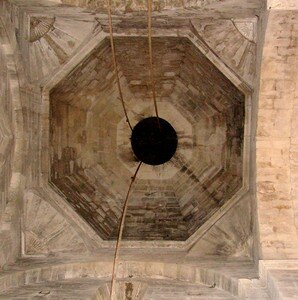

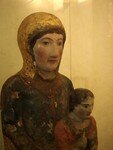






/https%3A%2F%2Fstorage.canalblog.com%2F12%2F98%2F137895%2F6624411_p.jpg)
/https%3A%2F%2Fstorage.canalblog.com%2F34%2F82%2F137895%2F27207854_p.jpg)
/https%3A%2F%2Fstorage.canalblog.com%2F32%2F37%2F137895%2F15872299_p.jpg)
/https%3A%2F%2Fstorage.canalblog.com%2F37%2F81%2F137895%2F15879822_p.jpg)